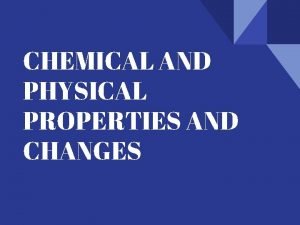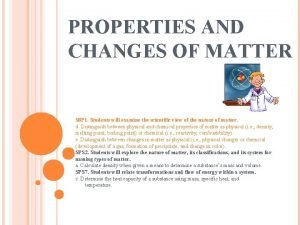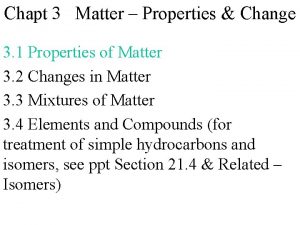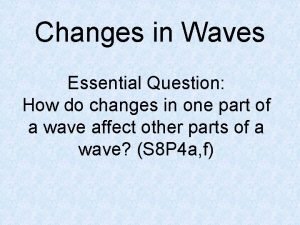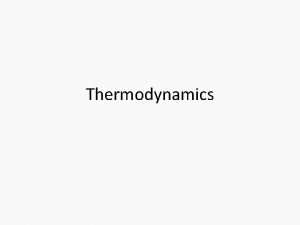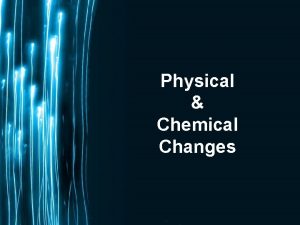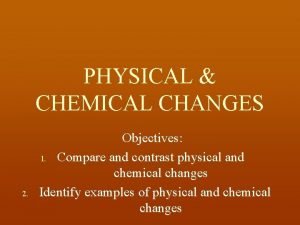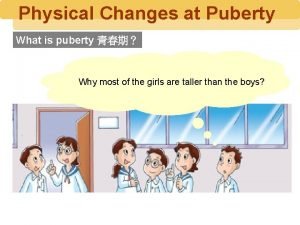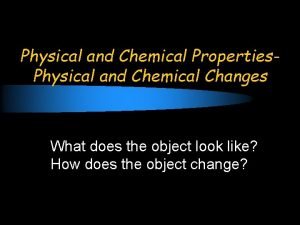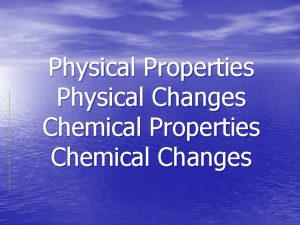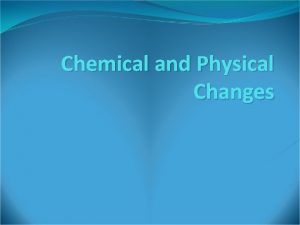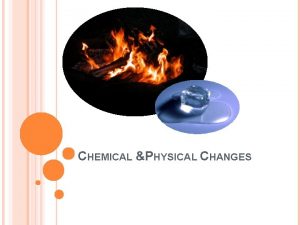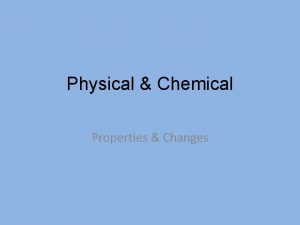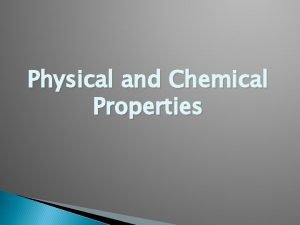2 Physical Properties vs Physical Changes Physical property


















- Slides: 18


2 Physical Properties vs Physical Changes • Physical property of a substance is a trait of the substance that can be observed OR can be measured by tools without changing the identity • Physical Change is a change in matter from one form to another but does not change identity

3 Chemical Properties vs Chemical Changes • Chemical property is a description of the ability of a substance to undergo, or not undergo, a change that will alter the composition of the original substance • Chemical change- occurs when there is a change in the arrangement of the atoms involved so a different substance with different properties is produced

The Phases of Matter

As a review • Matter is anything that has mass and volume. ▫ How do we measure them? ▫ Tools? ▫ Units? • The 2 types of matter that we have already talked about are: ▫ Pure substances ▫ Mixtures


Phases of Matter • There are four different states or phases of matter that we as humans associate with. ▫ ▫ Solid Liquid Gas Plasma • Each of the states have characteristics that define them as that particular state.

Characteristics of Solids • The particles are constantly vibrating, but they do not slip past one another • Because the particles do not slip past one another, a solid has a DEFINITE volume and shape. • Particles are closely packed together because there is an attractive force holding them together.

Solid Particle Diagram

Characteristics of Liquids • The particles can slip and slide past one another. • Because the particles can slip past one another, liquids DO NOT have a definite shape by themselves, but they do take the shape and volume of their container. • The particles are touching one another due to an attractive force holding them together. • The slipping allows the liquids to be poured.

Liquid Particle Diagram

Characteristics of Gases • The particles are moving in random directions. When particles collide, they bounce off one another and continue moving. • Gases do not have a definite shape or volume and fill the entire area of the container • The particles of gasses are not in contact with one another, because they can overcome the attractive forces.

Gas Particle Diagram

Characteristics of Plasma • High temperatures mean that the particles are moving at high speeds consisting of positively and negatively charged particles. • A substance is converted to the plasma phase at a very high temperature. Plasma does not have a definite shape or volume and fill the entire area of the container • The particles of plasmas are not in contact with one another, because they can overcome the attractive forces. • Plasma is the most common state of matter in the universe. ▫ Found in stars, lightning, bolts, neon, auroras and fluorescent light bulbs.

Plasma Particle Diagram

Demos


“Molecules on the move” activity • Partner up! • 1. What Phase is the matter starting with and ending with. ▫ Ex : Solid to liquid, Gas to Liquid • 2. Is heat being added or removed • 3. Tell me are the Molecules…. ▫ Speeding up (increasing energy) ▫ Slowing down (decreasing energy)
 Sample of chemical changes
Sample of chemical changes Physical/chemical changes & properties color by number
Physical/chemical changes & properties color by number Chemical property of matter
Chemical property of matter Elizabeth mulroney
Elizabeth mulroney Brainpop property changes
Brainpop property changes Properties and changes of matter worksheet
Properties and changes of matter worksheet Matter-properties and changes answer key
Matter-properties and changes answer key Changes in wave properties sorting activity
Changes in wave properties sorting activity Chemical properties and changes lesson 4
Chemical properties and changes lesson 4 Properties of and changes in matter grade 5
Properties of and changes in matter grade 5 Commutative and associative properties
Commutative and associative properties Classification of property under hindu law
Classification of property under hindu law Extensive properties thermodynamics
Extensive properties thermodynamics Intensive property and extensive properties
Intensive property and extensive properties Physical changes of old age
Physical changes of old age Physical and chemical changes
Physical and chemical changes Physical change
Physical change First sign of puberty in males
First sign of puberty in males Physical and chemical changes
Physical and chemical changes




